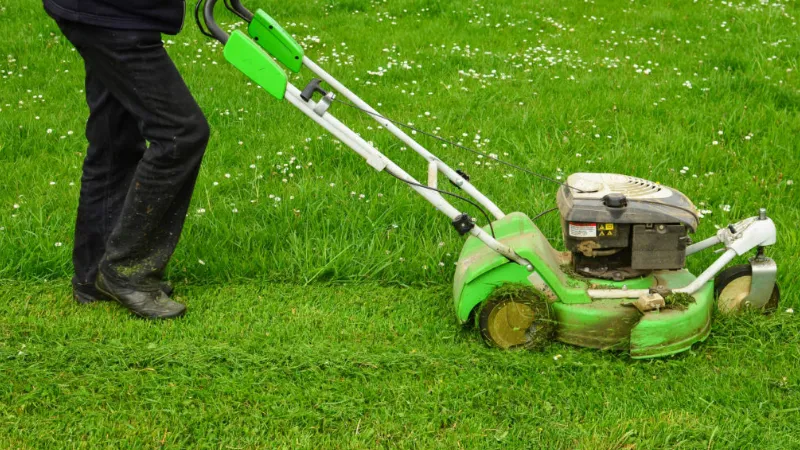My Prime Home explains how much water peace lilies require in this article, along with how often you should water them.
Water peace lilies about once every week, using typically one inch of water. A finger test can be used to determine whether the top layer of soil is consistently moist, which is something you want to make sure of. You do not want to let the soil dry out for long periods, or your plant will suffer from underwatering. Inadequate soil moisture can result in diseases like root rot, so watch out for this.
Continue reading.
How Often to Water Peace Lily?
Many indoor gardeners prefer to water on a regular schedule, especially novice ones with a small collection of houseplants. For Peace Lilies, this would mean watering around once per week, increasing the frequency in summer when temperatures are higher.
This practice, however, causes a number of problems. As much as we would like them to, they do not operate on a strict schedule. Like people, they are impacted by changes in their environments that may have an impact on how much water is still in the soil.
The actual moisture levels in the soil are ignored by using a schedule, despite the fact that it can be very helpful if you forget to water your plants. Several factors (discussed later) will impact how quickly the soil dries out and can change from day to day. A schedule will eventually result in underwatering or, worse, overwatering, which will cause several growth-related issues.
Rather, observe the soil closely every few days. It’s time to water once more as soon as you notice the soil’s top layer drying out. Don’t wait too long or you run the risk of wilting and yellowing. In a similar vein, avoid watering plants when the soil’s top layer is still damp because this can cause root rot.
This of course only applies if you have the right levels of drainage in the soil and the pot itself. Water that accumulates should be able to easily pass through soil particles and exit the container through the drainage holes at the bottom. This keeps the vital airflow around the roots flowing, supplying oxygen and warding off disease.
Even watering at the ideal time won’t be enough to protect your plants from harm without this drainage. Choose a container with drainage holes at the bottom (or you can drill your own) and use an airy houseplant potting mix containing a few handfuls of perlite and coconut coir when repotting.

Factors That Impact Watering Schedules
The best times to water your plants are never completely fixed because they depend on the environment. Take a look at these factors that can impact the levels of moisture in the soil. Keep an eye out for any adjustments, as they may affect the watering schedule day by day.
Light Levels
One of the most popular plants for areas with low lighting is the peace lily. They can adapt to most lighting levels except for direct sun, growing most successfully in bright indirect light indoors.
One of the main factors affecting how often you should water your plant is how much sunlight it receives. When left in low light, the moisture in the soil will evaporate far slower than it would with more sun. Additionally, the plant will grow more slowly and require much less water for photosynthesis. In order to maintain constant soil moisture levels without overwatering, you will need to water much less frequently.
In higher-light areas, moisture will evaporate much quicker. With a full day of bright indirect light, or even an hour or two of direct morning sun, your Peace Lily may need watering more than once per week. It all depends on the intensity of the light source and how it impacts moisture levels in the soil.
Once you’ve placed your plant in its ideal spot, take a couple of weeks to identify how the light levels impact soil moisture content. This should give you a better idea of approximately when you need to consider watering week by week.
Testing the soil prior to watering is essential, even if you have a general estimate. Wait a few days before watering again if the top layer still feels damp to the touch.
Temperature
Season and temperature have a longer-term impact on how frequently plants need to be watered. Peace Lilies need warm temperatures of around 75F throughout the year to grow successfully. But, as we all know, temperatures indoors aren’t always that conveniently consistent.
The soil will dry out a lot faster during times of higher temperatures, typically in the summer. If you want to avoid the problems associated with overwatering, you will need to water more often, potentially twice a week or more depending on the performance of the plant.
Evaporation will be slowed by abrupt temperature drops. If temperatures drop below 60F, the plant will also slow growth dramatically, absorbing far less water than normal.
The seasons usually bring about these changes. In fall and winter when temperatures are lower, your plant may only need water once every two weeks or so. As temperatures rise in the spring and summer, when growth is stimulated, this will rise. Keep an eye on your thermometer and how it may affect the soil.
Growth Rate
One of the key elements in the process of photosynthesis is water. Rapidly growing peace lilies will require more frequent watering because they will use up more moisture.
Your plant’s growth can be influenced by a number of factors, including fertilizing, light, and more. You’ll need to use your judgment and frequent soil checks to determine how quickly moisture is sapped from the soil.
Do Peace Lily Plants Need Lots of Water?
Water is very important to peace lily plants. Both the air and the soil are consistently moist in a happy, healthy peace lily. When these houseplants have regular, dependable access to fresh, clean water, they flourish.
The humid, warm climate of the rainforest is familiar to peace lilies. They have adapted to survive the dry season but they’re also quite at home in a continuously moist environment, so long as fresh oxygen is available to the roots. In peace lilies, root rot is caused by a deficiency in available oxygen for the roots rather than overwatering per se. Use quick-draining soil rather than a rich potting compost when growing peace lilies indoors.
How to Water a Peace Lily Plant Indoors?
In general, water your peace lily plant every two days. It might require daily watering in a dry climate. It might be fine with only receiving watering once or twice per week in a humid climate. Every day until you become accustomed to the soil moisture pattern of your potted peace lily indoor plant, check the moisture level with your fingers. You can also use a moisture meter to check soil dampness.
The ideal soil for peace lilies is porous, evenly damp, and provides the roots with sufficient access to both moisture and new oxygen. However, soggy, wet soil is bad. Moist soil is good. It is typically advised to use a soil mixture that is half potting soil and half orchid soil when re-potting your peace lily. In fact, peace lilies can flourish in ponded water as long as the flow is sufficient to supply the roots with new oxygen.
Even though they don’t like it, these plants are fairly hardy and can tolerate occasional soil drying out. Even live peace lily plants can be shipped across the country in packages.
Top watering tips:

How to Tell If Your Peace Lily Need Watering?
Great! Have you located the ideal location for your peace lily? Somewhere with lots of light but shade from the sun? Not close to a window or door where the temperature can change quickly and frequently?
Have you checked that the soil is humus based, or peat based potting compost and that it is very loose and well drained?
Fantastic, it’s time to meet your peace lily in person.
Yes, because peace lilies “talk to you”. They don’t use words, so we are not going to learn Spathiphyllum grammar, but they use their leaves and posture to tell you if they need water…
If you haven’t had a peace lily before, you will likely reach a point when the leaves have drooped and you will think, “My peace lily is losing life.” It happens to most pele but the reality is that it is just talking to you. It won’t perish unless you give it a lot of time to go unnoticed.
To show that they are thirsty, peace lily leaves begin to droop.
As long as you are aware of this and promptly water your plant, the leaves will quickly brighten and appear as though nothing was wrong. But… Take this as a lesson, and make the best of this event…
- As a helpful hint, note the number of days that pass before the tips of your Spathiphyllum’s leaves begin to droop after you first bring your peace lily home.
See, depending on the precise circumstances it is in, the plant will determine how long it will be until the next watering. Don’t worry; it will “calculate” the humidity, light, temperature, quality of the soil etc. What applications does this have?
- Calculate your watering schedule during this period. Just make sure that you water it one day before the time you have calculated. So, for example, if your peace lily sags on the 4th day from watering, give it some water on the 3rd…
What Happens If You Overwater Your Peace Lily?
Overwatering is one of the most common causes of plant decay and even death, and peace lilies are no exception. Thus, keep an eye out for early warnings.
- Your peace lily is beginning to turn yellow in the leaves. If it is not “dry yellow”, but they are soft and “full” but yellow, this is overwatering.
- Your peace lily’s leaves become less turgid and have a loss of texture. This indicates that your plant is actually starting to die due to overwatering, which has gone too far.

How to Save a Peace Lily from Overwatering?
Here’s the good news! If the roots are still healthy, you cam save your peace lily! And here is how:
- Disinfect a sharp blade and cut all the damaged leaves, from the base of the stem. In reality, that tissue is rotting, and rotting encourages bacteria, which spread to the rest of the plant. Be cruel at this point to be kind.
- Remove your peace lily from its container and scoop out all the soil. There could be bacteria in the soil.
- Check the roots of your peace lily.
- Cut all of the roots that exhibit rot with a sterile blade. They will be soft, unhealthy-looking, orange or yellowish, and at an advanced stage, brown.
- Sprinkle some sulphur powder on the wounds to the roots. This will eliminate all bacteria on the wounds and prevent their spread.
- Put fresh soil in a new pot for your peace lily.
You should stop watering it, right? You should just give it regular water; it won’t grow very tall. However, be careful; if it has reached this stage, you need to reduce the amount of water you give it.
Peace Lily Leaf Drooping
Is it bad for a peace lily to become sagging and start drooping its leaves? This is a crucial idea. There are two aspects of this phenomenon:
- If you act promptly, your peace lily will not suffer any immediate permanent damage after sagging. This holds true even if you wait a day or two (if it isn’t too hot and dry) before watering it.
- But this indicates that your peace lily is in trouble. Your houseplant is under stress, and stress can have very negative long-term effects on a plant’s health. The idea is to not panic if this occurs, but also to not let it happen too frequently.

FAQs
How Much Water Does a Peace Lily Need?
These plants thrive in evenly moist soil that dries out slightly between waterings in their natural habitat, which are tropical regions of Mexico, Central and South America, and Southeast Asia. To achieve this ideal moisture level, peace lilies require deep watering about once a week, as a general rule.
Do Peace Lilies Need Sunlight?
Lighting: Place peace lilies in a spot with bright but indirect sunlight. In order to expose the plant to the strong morning sun, an east-facing window is ideal. A peace lily would also do well in a window with a northward facing view.
Can You Overwater a Peace Lily?
Widespread yellowing foliage, brown leaf tips, generalized drooping, leaf spot diseases, and brown, mushy roots are the main signs of an overwatered Peace Lily. Major causes of overwatering include overpotting, soil that doesn’t drain well, and regular watering.
How Long Can Peace Lily Go Without Water?
If your pot and soil drain well, your peace lily will need to be watered every 7-10 days. If you live in a warm, dry area, your peace lily may need to be watered more often. You might need to water a bit less frequently if you live in a cooler or more humid climate.
Summary: How Often to Water Peace Lily?
Your success in growing Peace Lilies may depend on how well you water, but it need not be challenging. Keep an eye on moisture levels in the soil, improve drainage and watch for signs of over and underwatering to ensure you get it right.
If you have any questions, please leave a comment. My Prime Home tries to give you the best home improvement information. Thank you for reading.



